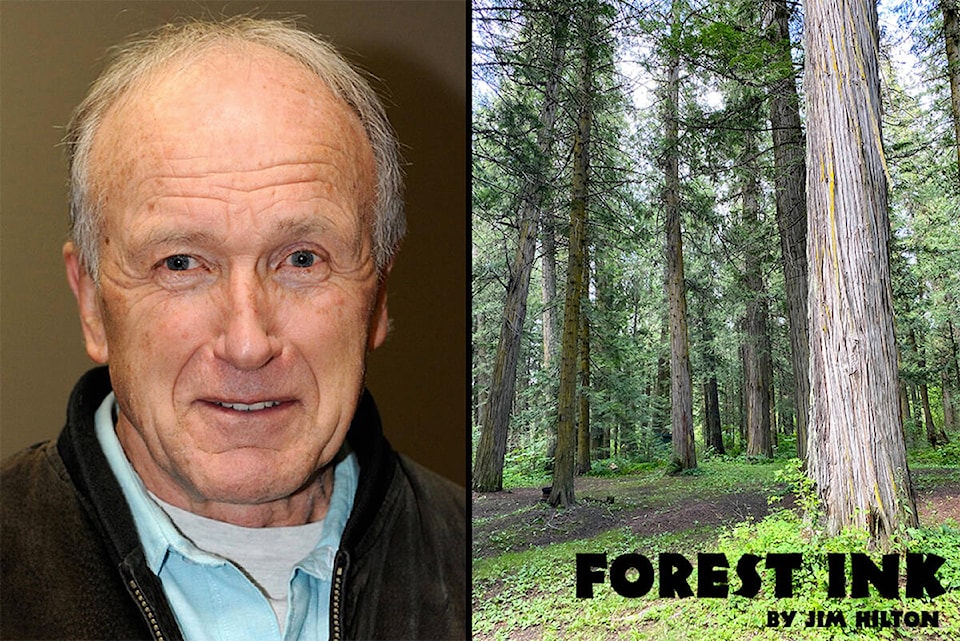A recent article published in Ecological Process by lead author William Beese is a good source to see what industry has done for the last two decades on using variable retention harvesting to counter some of the impacts of clear-cutting.
One of the goals of the study was to produce future forest stands that more closely resemble conditions that develop after natural disturbances, thereby maintaining greater diversity of habitats for a variety of organisms.
“For example, greater abundance of species present in the pre-harvest forest have been documented for vegetation, birds, carabid beetles, gastropods, ectomycorrhizal fungi and soil fauna in retention cutblocks compared to clear-cuts. There are, however, some negative consequences for timber production such as wind damage to retained trees and reduced growth rates of tree regeneration compared to clear-cuts.”
FOREST INK: Use old growth deferral period to look at future harvesting options
Some of the conclusions of the study were the following:
1. The landscape context determines what is necessary or appropriate for stand-level retention in relation to biodiversity conservation goals.
2. It is neither practical, nor likely even possible, to precisely mimic natural disturbance patterns.
3. Retention patterns around streams and lakes should be taken into account first because of their requirements and high-value habitat features.
4. Wind damage is a significant challenge for most stand-level retention, making aggregated retention or clear-cutting with reserves the most viable options for some sites in windy landscapes. I did not see any discussion on how the size of the clear cut blocks may have influenced the impact of wind.
5. Retention provides habitat that allows for some forest-associated organisms to persist after harvesting (i.e. life-boating), with a positive correlation between retention amount and species persistence. My interpretation is scarce scattered trees had little positive impact on diversity with numbers 6 and 7 repeating the same observation.
6. Growth impacts on forest regeneration increase with per cent canopy retention, and greater dispersion of single trees or small aggregates.
7. Typical retention levels (under 25 per cent do little to distinguish variable retention from clear-cutting in the eyes of the public unless trees are distributed as dispersed individuals or small aggregates.”
The authors suggest that after decades of experience applying variable retention harvesting to industrial-scale management of forest lands in B.C. it is possible to balance production of wood with biodiversity conservation.
While this is a worthy goal the data shown on Figure 2 is not as optimistic. Compared to clear-cutting the partial cutting and variable retention was about 20 per cent (my estimate) from 1998 to 2006 but less than 10 per cent for the next 10 years. The majority of the harvesting was from clear-cutting and clear-cut with reserves. Some companies did much better than others in trying to implement the alternate harvesting practices.
For example Wyerhaeuser’s British Columbia Coastal Group attempted the variable retention approach for all harvesting by 2003 after more than 75 per cent in 2001. For readers wanting to follow the discussion you will have to become familiar with the types of partial cutting like : seed tree, patch cut, shelterwood, selection systems, and intermediate cuts (e.g. thinning)
I will be the first to admit that I get lost in some of the jargon and would therefore recommend that readers go onto the provincial government site and see a tour of 12 types of harvesting practices involving some type of retention.
If you Google “Tour Stop 8. clear cut with reserves Gov.bc.ca” you will find some good pictures and explanations for the various types of retention.
Jim Hilton is a professional agrologist and forester who has lived and worked in the Cariboo Chilcotin for the past 40 years. Now retired, Hilton still volunteers his skills with local community forests organizations.
Do you have something to add to this story, or something else we should report on? Email: cassidy.dankochik@quesnelobserver.com
Like us on Facebook and follow us on Twitter.
